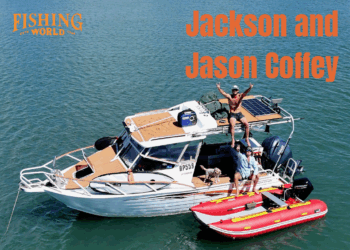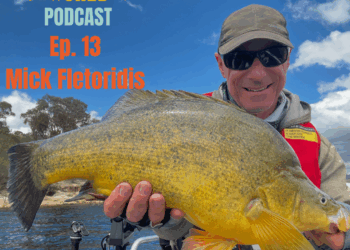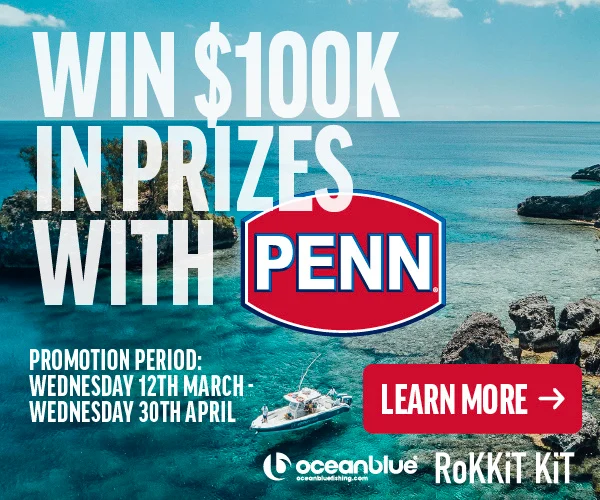(BRIAN Hay concludes his topical two-part essay on the plight of the Hawkesbury River region’s iconic jewfish with his vision for future management of this valuable fishery). Read Part 1 here.
So what is the answer?
IT would not be unreasonable to apply a complete ban on all sectors, recreational and commercial on the taking of mulloway in this system for say five years. Draw a line from Gerrin Point to Barranjoey or Palm Beach and close off everywhere inside this line. The Fisheries did it state-wide in the past with the blue groper and everyone is still amazed at how well the groper population recovered. Admittedly, the groper ban was for ten years but as the mulloway are a faster growing species the five years would probably be sufficient to turn things around.
A mulloway can reach spawning age between two and three years, the males are about 50cms and the females about 65cms. Fish of this size and smaller currently comprise 98 per cent of the commercial catch. Can you believe that these fish don’t even get a chance to spawn once with a legal length of only 45cms? I believe this length was originally arrived at because it comprised the bulk of the fish taken by the commercial sector and it was considered a waste of the resource to throw them back dead.
That 10 kilo fish we were previously talking about, which produces one to two million eggs per year, is only five years old. If we were really serious and closed the fishery for say ten years, when the closure ended there would be 18 -20 kilo fish everywhere. I think five years is more realistic with the aim of not so much growing big fish but to dramatically increase the numbers of mature spawning fish. After the five years, do a survey on numbers and if they are still too low then keep it closed and continue to review it. Once the spawning population increases to sustainable levels the numbers of the bigger fish would gradually reappear in the fishery.
I have great confidence in the resilience of wild fish populations and their ability to bounce back and replenish themselves. All they really need is a stable environment and to be left alone. They have the stable environment – we just need to leave them alone.
Of course a full five or ten year mulloway ban in the Hawkesbury system will never happen. The recreational sector would be forced to accept it but the commercial sector would scream blue murder. The reality is that it doesn’t matter what closures are put on, what legal lengths are introduced or what gear restrictions are applied, the bottom line is that while ever they set gill nets and trawl for prawns in the Hawkesbury River in summer they are going to catch and kill undersized mulloway. We just have to work toward getting these numbers down.
Introducing bycatch reduction devices in the trawler nets is a great initiative but the gill nets have been a real problem. Controlling the gill nets should not be all that hard and it wouldn’t cost much money to get these nets out of the system. There are only a handful of commercial fishermen who set gill nets throughout this area for jewfish and it would be of enormous benefit to remove them. These nets are not only set in the river or in Broken Bay but all around Killcare, Tallow Beach and Box Head and all the way round to Half Tide Rocks at the mouth of Brisbane Waters, legally and illegally. I have seen many nets that have broken away in big seas and rolled into a ball containing many big, rotting mulloway.
Closed Season
If a five or ten year ban is not acceptable then the next most effective management option is a closed season by all sectors and a complete ban on the taking of spawning fish by any means. This is especially critical when they are schooled up and moving along the beaches. They have closed seasons with barramundi in the Northern Territory and we do it here for trout. How crazy are we, we can protect an introduced species like trout and close the trout fishery while it is spawning but it’s open slather on mulloway, the icon and showpiece of our overfished saltwater fishery.
When the bigger, breeding mulloway come together to spawn, their movements and time frames are well known so they are easily targeted. There needs to be a complete ban on the taking of these fish by any means during the times they are schooling up and in roe. I have caught big fish in roe most months of the year in the Hawkesbury/Broken Bay system but the majority of the spawning fish in this area are in roe in January, February, March, April and some years May. At this time of the year they are schooling up around the headlands and beaches near the mouth of the river and these are the times when they really need protection. After they school up they then move on, spawn and then disperse till suitable conditions trigger spawning again, most times the following year.
Beach hauling of schooled up spawning fish is not an issue in the Hawkesbury/Broken Bay system, the numbers of big fish in this area is so low that it’s just not an option for the commercial sector to target them on the southern central coast beaches. However, from time to time schools of large spawning mulloway are targeted by beach haulers around Norah Head and the more northerly beaches of the central coast.
These big spawning fish taken by commercial beach haulers are a real mystery. We know so little about them; we don’t know where they come from, how far they have travelled to school up or where they go when they finish spawning and disperse. Some of these big schooling fish taken on the northern Central Coast beaches could very well originate from the Hawkesbury/Broken Bay system, no-one really knows.
What is well known is that most species of estuarine fish that spawn at sea nearly always head north from their chosen estuary. This takes advantage of the south flowing inshore currents that sweep the spawn or larvae back into the southern estuaries. As the Hawkesbury system is the only river system on the south end of the central coast, it’s not unreasonable to consider that it is being restocked from fish spawning on northern central coast beaches.
Compensation for the pros
In the event of any closures, commercial fishermen would be entitled to be compensated for loss of access to the resource, but realistically it shouldn’t cost all that much. It would seem fairly straightforward for State Fisheries to go through the fishermen’s catch returns, see how much money they had earned from mulloway for the past five years and pay that to them as compensation for loss of earnings for the next five years.
This would not amount to a large sum as Hawkesbury commercial fishermen have not made much money from jewfish for many years. This would be a good deal for commercial fishermen, realistically they would be compensated for fish they may never catch. Another option is a buy-back of active endorsements that enable them to target mulloway. The remaining non-active endorsements should either be surrendered or not able to be transferred. This would prevent the current practice of buying a non-active endorsement and starting to fish again after a previous active endorsement has been cashed in.
It should be noted that those in the commercial sector will be the major beneficiaries of any increase in mulloway populations if the complete closure ever eventuated. This will have to be closely monitored so we don’t lose the fish population overnight that it took five or ten years to replenish.
Recreational-only species?
Another option with merit may be declaring Hawkesbury mulloway as a non-commercial species. Its success in aquaculture is well proven and the increased production has been a real eye opener with regular supplies of quality fish available to consumers. Perhaps we should now consider banning the capture and selling of wild mulloway as another management tool. As stated previously, very few fishermen make much money from catching mulloway so the overall impact on the commercial sector would be minimal in the Hawkesbury system.
If a complete or partial closure does not eventuate then there are other management options that should be introduced as a matter of urgency. The obvious one is to further reduce the bag limit and increase the legal length for the recreational sector. I don’t know how effective this would be in the Hawkesbury system as there just aren’t that many big fish being caught these days, especially when you consider the effort that is being put in. As for consistently catching bigger fish, it’s rarely done and only the better fisherman that puts in the hours can catch two fish over 70cms in one session in the Hawkesbury system these days.Maybe a limit of just one fish over spawning length would be acceptable, at least fishermen would still be able to fish for mulloway and if they do catch that fish of a lifetime at least they will be able to keep it.
Well enough of this, I’ve said my piece. It’s well past time to push the panic button.
I don’t think there is any fishery in NSW under more threat than the mulloway in the Hawkesbury River, Broken Bay area. So let’s push that panic button, let’s get started to ensure future generations get the same opportunities as we have had. Let’s make sure we leave some for our kids and grandkids.
State Fisheries – it’s all up to you, do something.
Author’s bio: Brian Hay has been a recreational fisherman his whole life and has been involved with many fishing clubs, held most club positions and represented Avoca, Central Coast and NSW in all forms of competition. He bases his article on first hand knowledge gained from catching jews in the Hawkesbury River region for more than 50 years.




















